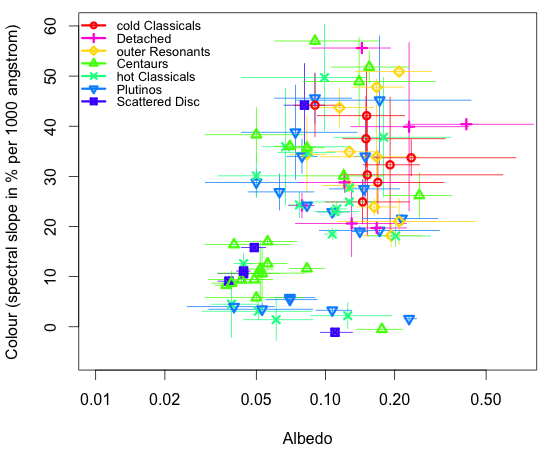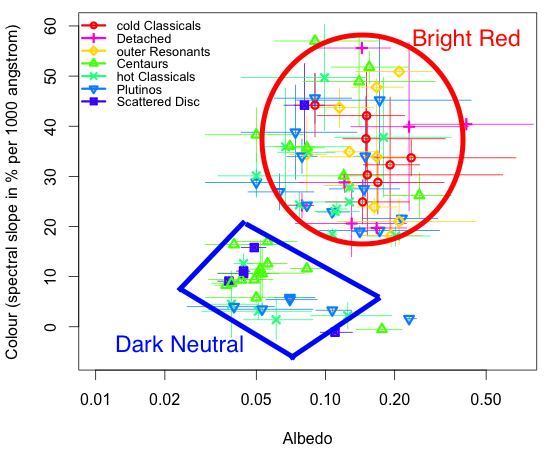Pedro Lacerda's homepage
Kuiper Belt Objects display a tremendous variety of surface colors, from slightly bluer than the Sun to extremely red. This surface variety is unparalleled in the solar system, and probably reflects a range of initial compositions because these objects have been exposed to the same environment for the last 4 Gyr or so. The different initial compositions probably also imply formation at different distances from the Sun. If KBOs had all formed at the same distance from the Sun and hence at similar temperatures, we should expect them to have the same composition.
When we combine the color information with albedo data measured using the Herschel Space Observatory, we find that KBOs form two groups, one with redder surfaces (steeper spectral slopes) and brighter surfaces (higher albedo), and another with more neutral and darker surfaces.

What is most interesting is that KBOs in dynamical classes believed to have formed beyond Neptune (cold Classical KBOs, detached KBOs, KBO in outer resonances) all have surfaces in the bright-red group. Dynamical classes including objects that were scattered into the Kuiper belt region (hot Classicals, Scattered Disc, etc) appear in both surface types.

The current orbits of the objects with bright-red and dark-neutral surfaces are not clearly distinct, so the different surfaces are not caused by ongoing effects. The two surfaces must originate early and so they are an indication that the composition of objects formed beyond Neptune may have been different.

See also these pages and papers:
- The Albedo-Color Diversity of Transneptunian Objects, by Pedro Lacerda et al.
- The formation of the solar system, by Susanne Pfalzner et al.
- The Kuiper Belt, by David Jewitt
- Surfaces of Kuiper Belt Objects, by David Jewitt
- H/WTSOSS, by Wesley Fraser.
- The bimodal colors of Centaurs and small Kuiper belt objects, by Nuno Peixinho et al.
- The Color Differences of Kuiper Belt Objects in Resonance with Neptune, by Scott Sheppard
- A compositional interpretation of trans-neptunian objects taxonomies, by Cristina Dalle Ore et al.
This work was partly funded by the Royal Society through a Newton Fellowship.
Pedro Lacerda, January 2015